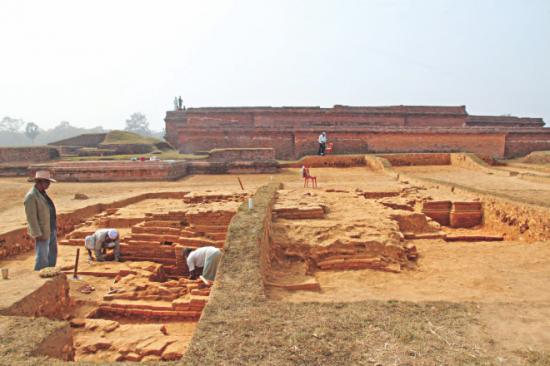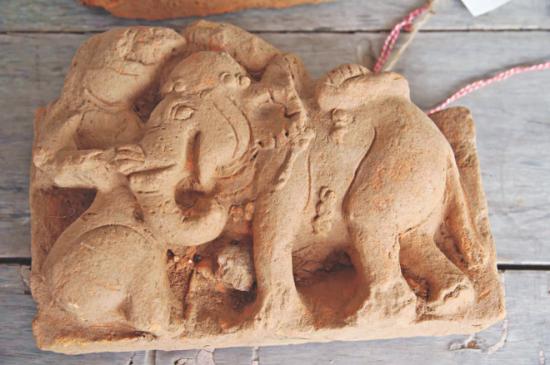Yasmin Reema
Source - http://www.thedailystar.net/cruciform-temple-unearthed-12330

Excavation is on at Shalban Bihar of Comilla, where a Buddhist temple and relics have lately been unearthed. Photo: Star
A recent excavation of Shalban Bihar in Comilla has unearthed a cruciform Buddhist temple and 70 terracotta plaques, which are believed to date back to a period in between ninth and 11th centuries.
The artefacts were found on the eastern side of the main temple of the bihar, the best known for Buddhist monastery in the Indian subcontinent.
The upper side of the excavated temple had been destroyed and its basement was still buried, Department of Archaeology Chittagong Regional Director Mizanur Rahman, who led the excavation, told The Daily Star.
"We will try to dig the rest of it once we resume the excavation works in the next phase," he said on completion of the latest phase of excavation that ended on February 10.

Terracotta plaque and idol, two of around 70 discovered artefacts that date back to ninth and 11th centuries. Photo: StarTerracotta plaque and idol, two of around 70 artefacts that date back to ninth and 11th centuries. Photo: StarWith an allocation of Tk 5 lakh by the Ministry of Cultural Affairs in the ongoing fiscal year, the latest phase started on December 14 last year.
The excavated part of the temple is 1.25 metre high from the ground. A stupa and terracotta plaques were also found in the digging.
Lion-elephant fight, lotus, monkey, boar, deer and fish are among the most common scenes inscribed on those plaques.
Soharab Uddin, head of the Department of Archaeology at Comilla University, said, "Made of terracotta bricks, the temple is of excellent design."
Stretching over 702.25 square feet area, the temple has four arms, each 99-centimetre long. It has stairs on three sides, each having five steps.
Once a self-contained Buddhist monastery, Shalban Bihar, which is also known as Bhavadeva's Mura after the name of King Bhavadeva who built it in the 8th century, sits in the middle of Mainamati-Lalmai range dotted with over 55 ancient Buddhist temples.

Terracotta plaque and idol, two of around 70 discovered artefacts that date back to ninth and 11th centuries. Photo: StarTerracotta plaque and idol, two of around 70 artefacts that date back to ninth and 11th centuries. Photo: Star
In the phases of excavation started back in 1955, artefacts, monastic cells, a central shrine and a number of subsidiary shrines have so far been discovered where monks lived, studied and prayed.
The plaques and artefacts discovered since then have been kept at Mainamati Museum, which was built in 1966 beside the Shalban Bihar. Rest of the plaques were sent to Dhaka due to the shortage of space in the museum.
Soharab Uddin said terracotta and sculptures might be found by digging no fewer than 100 points in the bihar.